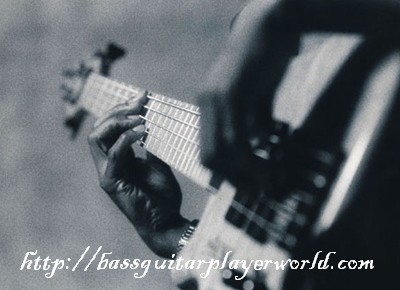Minor Pentatonic Scales – Patterns And Positions
 The most popular scales in hard rock and heavy metal are the pentatonic scales. The scales are revered for their simplicity and ease of use, as well as their interval spacing.
The most popular scales in hard rock and heavy metal are the pentatonic scales. The scales are revered for their simplicity and ease of use, as well as their interval spacing.
Today, we will be discussing the minor pentatonic scales for bass guitar. Before we get into the scales, it is important that you know your fret board. It will be difficult to learn a scale if you don’t actually understand the notes.
Take time to learn the notes and note spacing on your fret board. This will give you the tools necessary to tackle the minor pentatonic scales.
Learn And Master the Scales Under Your Belt
First off, the most important part of any scale is becoming familiar with its properties. The easiest way to train your ear to scale properties is to pick out the overall sound of a scale. Major scales tend to sound upbeat and powerful, while minor scales tend to sound more fragile and sad. Obviously being a minor scale, the pentatonic minor scale has a depressive undertone.
The popularity gained by the pentatonic scale, as stated before, has a lot to do with its intervallic spacing. Pentatonic scales translate fairly easily to the fret board of both the bass guitar and the regular guitar.
How the Scale is Formed – The Magic Formula
The pentatonic minor scale follows a simple spacing. From tonic to leading tone, the pentatonic scales spacing is; one and a half steps, whole step, whole step, one and a half steps, and whole step. On a bass guitar or guitar neck, these intervals are extremely easy to achieve.
 Take for example the A minor pentatonic scale. This scale consists of the notes A, C, D, E and G. The C is a minor third from the root, the D is a perfect fourth from the root, the E is a perfect fifth from the root, and the E is a minor seventh from the root. This gives the minor pentatonic scale an extremely unique sound, almost Asian in quality. This is because the bass pentatonic scale is an Asian styled scale.
Take for example the A minor pentatonic scale. This scale consists of the notes A, C, D, E and G. The C is a minor third from the root, the D is a perfect fourth from the root, the E is a perfect fifth from the root, and the E is a minor seventh from the root. This gives the minor pentatonic scale an extremely unique sound, almost Asian in quality. This is because the bass pentatonic scale is an Asian styled scale.
While it doesn’t achieve the sound within the context of heavy metal, if you have ever heard sad music in a Chinese buffet, then you have heard the minor pentatonic scale at work. This goes to show how truly adaptable the minor pentatonic is.
Applying Your New Knowledge
So now you know how to form a minor pentatonic scale, and you understand its properties. Next you have to learn to put the minor pentatonic scale to practical use. Because the A minor pentatonic scale is very similar to the A minor scale, this means that you can play it over the A minor scale.
All minor pentatonic scales maintain a close relation to their root scales. This means that a G minor pentatonic scale can be played over a G minor chord progression, and a B minor pentatonic scale can be played over a B minor chord progression. This is all because they share the same notes. Try to use the minor pentatonic scales to achieve different qualities and textures for your music.
Keep your mind open to new ideas, and above all, practice hard and have fun!
See Huge Improvements In Your Playing Immediately
If you are serious about learning to play the bass, check out JamPlay. They offer the best online instructional content to help you achieve short term and long term goals. With lessons taught by some of the most famous bassists in the world and new content being added on a weekly basis, you can learn whatever you want at your own convenience!
Jamplay is absolutely fantastic and is highly recommended. Check them out today!
Related Articles
Comments are closed.






Recent Comments